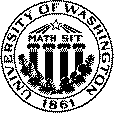The Course
This course covers a few miscellaneous topics from calculus. Most of our time will be spent on calculus in three
dimensions. This part of the course is interesting because we actually live in three dimensional space. We first cover the basics of
analytic geometry in three-space. We then discuss parametric equations and introduce the differential
calculus of vector valued functions. This part of the class finishes with an introduction to multivariable integration. The last two weeks are devoted to a study of sequences and
series. This culminates in Taylor's beautiful theorem. This material is useful for solving differential equations and for
making approximations. We will use locally produced notes for this part of the class instead of the textbook. These notes are available here.
Grades
Your grade is determined by how you do relative to the class as a whole. Grades will be based
on total points earned.
There are 320 possible points:
- Worksheets--20
- Homework--50
- Quizzes--50
- 2 Midterms--50 points each
- Final--100
back to the top
Homework
will be assigned daily, see the
WebAssign site for the problems due. You are responsible for all the
problems assigned (ie: any of it could appear on the exams). The problems assigned during the week will be due at 11pm on the following Tuesday.
Quizzes and Exams
- There will be a 20 minute quiz every Tuesday, except for the weeks of the exams. These will usually cover the homework
from the preceeding week. They will be very similar to the homework problems. The TA's will grade them and
return them to you the following Thursday. The quizzes are closed book/closed notes. There are no make up quizzes, but I
do drop your lowest quiz score.
- There will be 2 midterm exams. They
will be given on the dates listed in the syllabus. You must bring a Photo ID to all exams.
- The final exam
will take place from 1:30pm to 4:20pm on Saturday, June 8. Note that this is not the time listed
in the final exam schedule.
It will be held in
Guggenheim 220.
back to the top
Rules for taking exams
- You are allowed to use one handwritten 8.5 by 11 sheet of notes.
- Graphing calculators are not allowed on exams or quizzes. You may use a scientific calculator.
- There are no make-up exams. If you have a compelling and
well-documented reason for missing a test, speak to the professor about it.
Quiz section
On Tuesdays and Thursdays you will meet with a Teaching Assistant in a smaller group.
This gives you a chance to get more of your questions answered. In addition to getting help with your homework, there
will be time for a worksheet that you can work on while the TA circulates and answers questions. Most
weeks there will be a quiz on Tuesday. The midterm exams will be held in Quiz Section.
The TA's are:
| Sections | Name | Office | Email |
| GA & GB | Josh Swanson | PDL C-8B
| jps314[_a_t_]math.washington.edu |
| GC & GD |
Dake Wang | PDL C-541 |
dkpool[_a_t_]math.washington.edu
|
Text
Calculus, Early Transcendentals by James Stewart
(The Seventh Edition).
Calculators
You will need a scientific calculator for Math
126. It must have trigonometric functions, like Sin and Cos, as well as
logarithms and exponentials (ln and exp). I recommend the HP-6S, which
costs about $15 at the U Bookstore. The Sharp EL-500LB is also a good
choice. It is a little less easy to use, but costs only $10.
Graphing
calculators are not allowed on quizzes and exams in Math 126. A graphing
calculator is any device with a multiline display that has the ability to
graph mathematical functions. Examples are the TI-85 or the HP-48G. Calculators like the CASIO fx-115ES PLUS that can do some basic calculus are also not allowed. See
your instructor before the first quiz if you are not certain if your
calculator is acceptable.
back to the top

